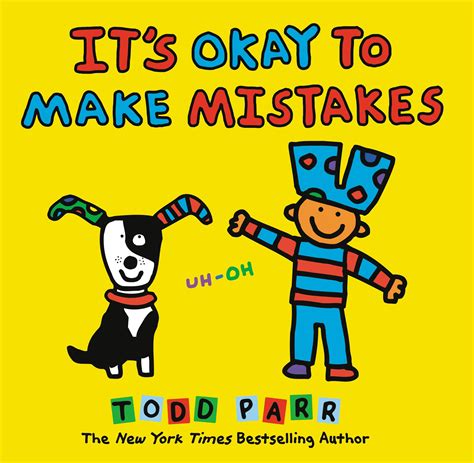SEL Read Aloud: It’s Okay to Make Mistakes by Todd Parr

Summary
The book “It’s Okay to Make Mistakes” by Todd Parr is a perfect SEL read aloud for younger readers. It presents a dozen scenarios in which children (and even some grown ups) may feel embarrassed or ashamed with reassurance that these things are “okay”; they can ultimately be fixed, allow you to learn, or maybe even lead to things better than you thought were possible. It’s a great reminder that many of the things we say we don’t want to do (e.g. fall down) allow us to practice the things we want to do most of all (e.g. learn how to get back up).
Comprehension Questions
Six questions aligned to Bloom’s taxonomy for teacher’s to evaluate students’ comprehension
- Remembering: What is one activity mentioned that you can still enjoy even if you’re clumsy?
- Understanding: How does making mistakes help us, according to the book?
- Applying: How might you apply the idea of “it’s okay to make mistakes” in your own life?
- Analyzing: What patterns do you notice in the ways the book suggests handling mistakes or challenges?
- Evaluating: Assess the book’s suggestion that it’s okay to change your mind. Do you agree? Why or why not?
- Creating: Create a scenario where making a mistake leads to a positive outcome, inspired by the book.
CASEL Discussion Questions
Five questions aligned to the CASEL competencies for teachers to foster an engaging discussion and foster social-emotional learning
- Self-Awareness: How can admitting you don’t know the answer and asking questions improve your self-confidence and self-understanding?
- Self-Management: What strategies does the book suggest for managing feelings of upset or frustration?
- Social Awareness: How does the book’s message about wearing two different socks and potentially inspiring others demonstrate understanding and empathy towards diverse perspectives?
- Relationship Skills: How can admitting mistakes and learning from them improve relationships with peers and adults?
- Responsible Decision Making: How does changing your mind, as the book suggests, relate to making thoughtful, informed decisions?
Design Thinking Challenge
Take students’ learning even further by incorporating the Imagineerz design thinking framework
Create an “oops-a-daisy” convertor
Understand
- Begin by revisiting “It’s Okay to Make Mistakes” by Todd Parr, focusing on instances where mistakes lead to unexpected discoveries or happy accidents.
- Lead a discussion on how mistakes are often viewed negatively and ask students to think about tools or devices that could turn mistakes into something positive or funny.
Ideate
- Challenge students to come up with ideas for an “oops-a-daisy” converter, a fictional device that transforms everyday mistakes into amusing or positive outcomes. For example, a spill might become a cool design, or tripping could activate a funny sound effect.
- Encourage creativity and out-of-the-box thinking about how these devices can make light of common mishaps, using simple mechanisms or technology.
Prototype
- Divide students into small groups and have them select their favorite “oops-a-daisy” converter idea to prototype. They should sketch their design, considering how it would work, what materials they need, and how it transforms a mistake.
- Provide a variety of materials for prototyping, such as cardboard, tape, rubber bands, or springs.
Test
- Organize a classroom showcase where each group demonstrates their “oops-a-daisy” converter. Have them explain the mistake it addresses and demonstrate how the device transforms it into a positive or humorous outcome.
- Encourage the audience to provide feedback on the effectiveness of the transformation, the creativity of the solution, and suggestions for improvement.
- Reflect on the process of designing and creating devices that embrace mistakes. Discuss what students learned about viewing mistakes through a positive lens and how their devices could change perceptions of mistakes in real life.
Read Aloud
If you appreciated getting to read this book with your class, you might also want to share this book with them!
Additional Resources
Copyright Notice
The image on this page comes from the book It’s Okay to Make Mistakes by Todd Parr. Copyright © 2014 by Todd Parr.


